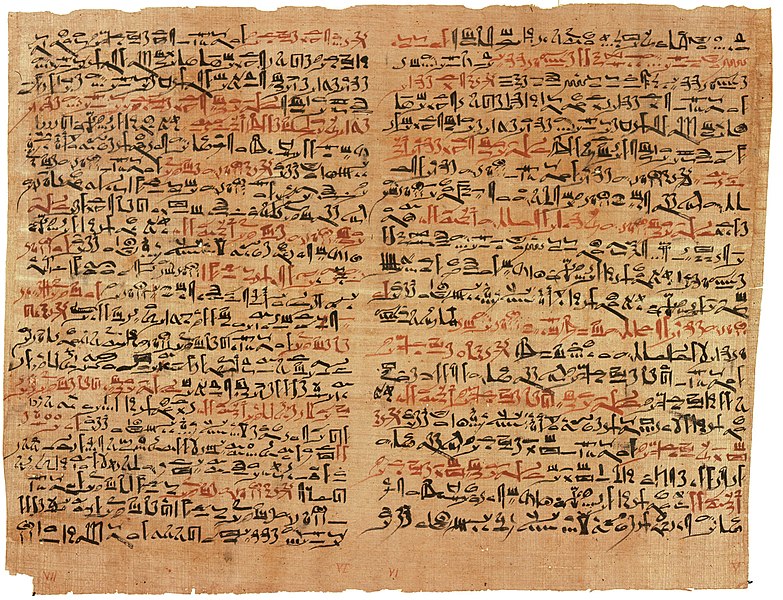File:Edwin Smith Papyrus v2.jpg
Jump to navigation
Jump to search

Size of this preview: 783 × 600 pixels. Other resolutions: 313 × 240 pixels | 627 × 480 pixels | 1,002 × 768 pixels | 1,280 × 981 pixels | 2,550 × 1,954 pixels.
Original file (2,550 × 1,954 pixels, file size: 1.95 MB, MIME type: image/jpeg)
File history
Click on a date/time to view the file as it appeared at that time.
| Date/Time | Thumbnail | Dimensions | User | Comment | |
|---|---|---|---|---|---|
| current | 02:54, 4 October 2007 |  | 2,550 × 1,954 (1.95 MB) | Jeff Dahl | cleanup {{pd-old}} |
| 02:52, 4 October 2007 |  | 2,550 × 1,954 (1.95 MB) | Jeff Dahl | {{Information |Description=Cleaned up version of Image:EdSmPaPlateVIandVIIPrintsx.jpg, available {{pd-old}} |Source=self-made |Date=10-3-07 |Author= Jeff Dahl }} |
File usage
The following 2 pages use this file:
Global file usage
The following other wikis use this file:
- Usage on af.wikipedia.org
- Usage on am.wikipedia.org
- Usage on anp.wikipedia.org
- Usage on ar.wikipedia.org
- بوابة:التاريخ
- جراحة الأعصاب
- بوابة:فلسفة/مقالة مختارة
- عملية تجميل الأنف
- مصر القديمة
- كتابة هيراطيقية
- الكتابة في مصر القديمة
- بردية
- الطب في مصر القديمة
- إصابة دماغية رضية
- مستخدم:عمرو/مصر القديمة
- مستخدم:Ibrahim.ID/سجل الأعمال
- ويكيبيديا:جائزة المنتج - النصف الأول لعام 2014/Ibrahim.ID
- بردية إدوين سميث
- ويكيبيديا:ترشيحات الصور المختارة/بردية إدوين سميث
- ويكيبيديا:صور مختارة/رسومات وجداول وخرائط/مخطوطات
- بوابة:التاريخ/صورة مختارة/أرشيف
- بوابة:التاريخ/صورة مختارة/14
- ويكيبيديا:صورة اليوم المختارة/فبراير 2015
- قالب:صورة اليوم المختارة/2015-02-23
- بوابة:الشرق الأوسط القديم/مقالة مختارة
- بوابة:الشرق الأوسط القديم/مقالة مختارة/14
- ويكيبيديا:صورة اليوم المختارة/أبريل 2016
- قالب:صورة اليوم المختارة/2016-04-02
- الدراسات التشريحية المصرية القديمة
- حروف متصلة
- تاريخ المنهج العلمي
- ويكيبيديا:صورة اليوم المختارة/يونيو 2017
- تاريخ الجراحة
- قالب:صورة اليوم المختارة/2017-06-10
- مستخدم:محمد 19951/ملعب9
- بوابة:فلسفة/مقالة مختارة/8
- ويكيبيديا:صورة اليوم المختارة/فبراير 2018
- قالب:صورة اليوم المختارة/2018-02-23
- ويكيبيديا:صورة اليوم المختارة/مايو 2019
- قالب:صورة اليوم المختارة/2019-05-22
- ويكيبيديا:صورة اليوم المختارة/أكتوبر 2020
- قالب:صورة اليوم المختارة/2020-10-06
- تاريخ سكان مصر
- ويكيبيديا:صورة اليوم المختارة/نوفمبر 2023
- قالب:صورة اليوم المختارة/2023-11-01
- Usage on arz.wikipedia.org
View more global usage of this file.


